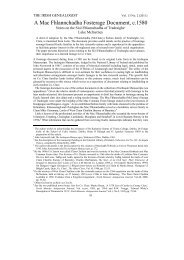Report Cover Vol I - Clare County Library
Report Cover Vol I - Clare County Library
Report Cover Vol I - Clare County Library
You also want an ePaper? Increase the reach of your titles
YUMPU automatically turns print PDFs into web optimized ePapers that Google loves.
The <strong>County</strong> <strong>Clare</strong> Wetlands Survey Patrick Crushell & Peter Foss 2008<br />
___________________________________________________________<br />
Poor fen and flush<br />
Poor fen and flushes include<br />
peat-forming communities that<br />
are fed by groundwater or<br />
flowing surface waters that are<br />
acid. In most cases the<br />
substratum is acid peat which<br />
has a higher nutrient status<br />
than that of surrounding acid<br />
bogs. The vegetation of poor<br />
fens and flushes is typically<br />
dominated by sedges and<br />
extensive carpets of mosses, in<br />
particular, Sphagnum moss.<br />
Poor fens occur in a variety of<br />
situations including areas<br />
flushed by moving water in<br />
upland and lowland blanket<br />
bogs, flushed depressions in<br />
grassland areas, cutover bogs<br />
and wet heath areas.<br />
Like most peatland types in Ireland, poor fens have declined in extent mostly as a result of activities such as<br />
peat cutting and mining, afforestation, agricultural drainage, infilling, and fertiliser pollution and eutrophication.<br />
Present throughout many of the upland bog sites within the county such as Lough Acrow Bogs NHA.<br />
Transition mire and quaking bog<br />
Annex 1 habitat under the EU Habitats Directive.<br />
Transition mires and quaking bogs are peat-forming<br />
communities developed at the surface of waters with<br />
little or moderate amounts of nutrients, with<br />
characteristics intermediate between rich (alkaline)<br />
and poor (acidic) fen types. For this reason, they are<br />
considered as a separate habitat but they may occur<br />
within, or on the fringes of other peat-forming<br />
systems.<br />
They present a large and diverse range of plant<br />
communities. In large peaty systems, the most<br />
prominent communities are swaying swards, floating<br />
carpets or quaking mires formed by medium-sized or<br />
small Sedges, associated with Sphagnum or brown<br />
mosses.<br />
Transition mires and quaking bogs are usually<br />
associated with the wettest parts of a bog or fen and<br />
can be found in wet hollows, infilling depressions, or<br />
at the transition to areas of open water.<br />
The vegetation frequently forms a floating mat or<br />
surface scraw over saturated, spongy or quaking<br />
peat. Standing water may occur in pools or along<br />
seepage zones. The vegetation typically comprises<br />
species that are characteristic of bog, fen and open<br />
water habitats.<br />
In some cases the mire occupies a physically<br />
transitional location between bog and fen vegetation,<br />
for example on the margin of a raised bog, or may<br />
be associated with certain valley and basin mires.<br />
Like most peatland types in Ireland, transition mire have declined in extent mostly as a result of activities such<br />
as peat cutting and mining, afforestation, agricultural drainage and reclamation, infilling, and fertiliser pollution<br />
from adjacent farmland.<br />
Extensive patches of this habitat were recorded from the area around Oystermans Marsh NHA.<br />
32
















